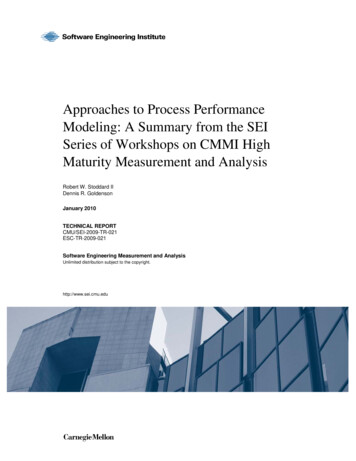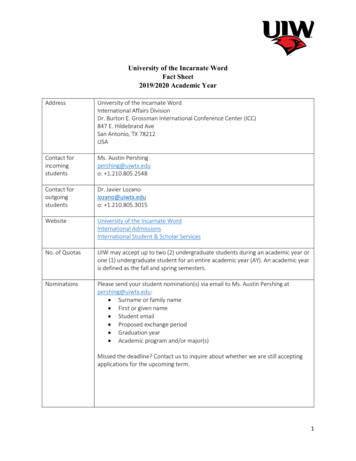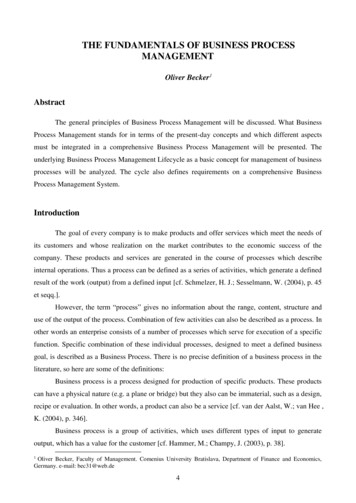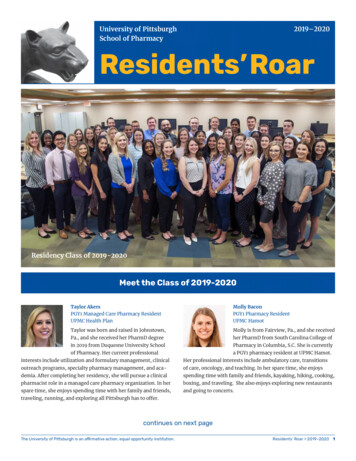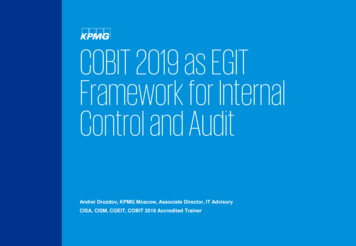
Transcription
Office ofInstitutionalResearch andAssessmentAugust 14, 2020Revised August 26, 2020PERFORMANCE MANAGEMENTPROCESS2019-2020 DATA BOOK
University Performance Management Process2019-20 Data BookTable of ContentsPillar: Access and Completion . 1Goal 1: CUNY will expand online education, supporting the necessary infrastructure, training andincentives. 1Percentage of instructional (student) full-time equivalencies (FTEs) enrolled in partially or totally online courses. 1Goal 2: CUNY will widen its doors to adult and returning students so that they can earn the degrees thatwill boost their careers and can change the trajectories of families. . 2Percentage of undergraduate students 25 years or older . 2CONTEXT: Number of undergraduate students 25 years or older . 3Goal 3: CUNY will increase representation of Under-represented Minority (URM) students. . 4Undergraduate students: Percentage who are Black. 4CONTEXT: Undergraduate students: Number who are Black . 5Undergraduate students: Percentage who are Hispanic. 6CONTEXT: Undergraduate students: Number who are Hispanic . 7Undergraduate students: Percentage who are American Indian or Native Alaskan . 8CONTEXT: Undergraduate students: Number who are American Indian or Native Alaskan . 9Goal 4: CUNY colleges will launch college momentum campaigns to raise on-time graduation rates. . 10Percentage of fall full-time first-time freshmen retained in the spring . 10Percentage of fall full-time first-time freshmen retained in the fall (1 year) . 11Percentage of fall full-time first-time freshmen retained in the fall as full-time (1 year) . 12Percentage of fall full-time first-time freshmen in baccalaureate programs who earn 30 credits or more in the first year . 13CONTEXT: Percentage of fall full-time first-time freshmen in baccalaureate programs who earn 20 credits or more in thefirst year . 14Percentage of fall full-time first-time freshmen in baccalaureate programs who earn 30 credits or more in the fall and springsemesters . 15CONTEXT: Percentage of fall full-time first-time freshmen in baccalaureate programs who earn 20 credits or more in the falland spring semesters. 16Percentage of fall full-time first-time freshmen in associate programs who earn 30 credits or more in the first year . 17CONTEXT: Percentage of fall full-time first-time freshmen in associate programs who earn 20 credits or more in the firstyear . 18Percentage of fall full-time first-time freshmen in associate programs who earn 30 credits or more in the fall and springsemesters . 19CONTEXT: Percentage of fall full-time first-time freshmen in associate programs who earn 20 credits or more in the fall andspring semesters. 20Percentage of fall full-time first-time freshmen in baccalaureate programs who pass Gateway English in the first year . 21August 14, 2020CUNY Office of Institutional Research and AssessmentPage i
University Performance Management Process2019-20 Data BookCONTEXT: Percentage of fall full-time first-time freshmen in baccalaureate programs who pass Gateway English in the falland spring semesters. 22Percentage of fall full-time first-time freshmen in baccalaureate programs who pass Gateway Math in the first year . 23CONTEXT: Percentage of fall full-time first-time freshmen in baccalaureate programs who pass Gateway Math in the falland spring semesters. 24Percentage of fall full-time first-time freshmen in associate programs who pass Gateway English in the first year . 25CONTEXT: Percentage of fall full-time first-time freshmen in associate programs who pass Gateway English in the fall andspring semesters. 26Percentage of fall full-time first-time freshmen in associate programs who pass Gateway Math in the first year . 27CONTEXT: Percentage of fall full-time first-time freshmen in associate programs who pass Gateway Math in the fall andspring semesters. 28Transfer rate of associate (AA/AS) graduates to any baccalaureate program . 29Student experiences taking courses at campuses other than their home college . 30Goal 5: CUNY is uniquely positioned to bridge opportunity gaps and increase students' potential for collegeattendance, graduation, and careers. . 31Gap in the one-year retention rates of underrepresented minority and non-underrepresented minority first-time freshmenenrolled in baccalaureate programs (full-time entrants) . 31Gap in the one-year retention rate of underrepresented minority and non-underrepresented minority first-time freshmenenrolled in associate programs (full-time entrants) . 33Gap in the one-year retention rate between men and women first-time freshmen enrolled in baccalaureate programs (fulltime entrants) . 36Gap in the one-year retention rates of men and women first-time freshmen enrolled in associate programs (full-timeentrants). 38Goal 6: CUNY will double its three-year graduation rate for associate degrees and raise by ten points thesix-year graduation rate for baccalaureate programs. . 41Two-year graduation rate of associate full-time first-time freshmen (completed at college of entry) . 41Three-year graduation rate of associate full-time first-time freshmen (completed at college of entry) . 42CONTEXT: Four-year graduation rate of associate full-time first-time freshmen (completed at college of entry). 43Gap in actual and predicted three-year graduation rate of associate full-time first-time freshmen (completed at college ofentry). 44Four-year graduation rate of students who transferred from an associate degree program to a CUNY baccalaureateprogram (tracked from semester of transfer) . 45Percentage of degree-seeking associate first-time freshmen who earn a degree (associate or baccalaureate) or transfer toa CUNY baccalaureate program or to a non-CUNY four year college within six years. 46Four-year graduation rate of full-time first-time freshmen in baccalaureate programs (completed at college of entry). 47Six-year graduation rate of full-time first-time freshmen in baccalaureate programs (completed at college of entry) . 48CONTEXT: Eight-year graduation rate of full-time first-time freshmen in baccalaureate programs (completed at college ofentry). 49August 14, 2020CUNY Office of Institutional Research and AssessmentPage ii
University Performance Management Process2019-20 Data BookGap in actual and predicted six-year graduation rates of full-time first-time freshmen in baccalaureate programs (completedat college of entry) . 50Accelerated Study in Associate Programs (ASAP) Three-year graduation rate of full-time first-time freshmen (completed atcollege of entry) . 51CONTEXT: Accelerated Study in Associate Programs (ASAP) Enrollment . 52Pillar: College Readiness . 53Goal 1: CUNY will strengthen its partnership with the city’s schools to ensure more high school graduatesare college ready, and, for those who are not, CUNY will improve the effectiveness of its remediationprograms. 53Percentage of College Now enrollment target achieved . 53CONTEXT: Percentage of first-time freshmen previously enrolled in College Now or the Early College Initiative (ECI) . 54CONTEXT: Percentage of advanced transfer students previously enrolled in College Now or the Early College Initiative(ECI) . 55CONTEXT: Percentage of first-time freshmen who enroll with six or more college credits. 56Percentage of fall first-time freshmen enrolled of those accepted . 57Percentage of first-time freshmen in associate programs with initial math remedial need who exited remediation in math viathe University Skills Immersion Program (USIP). 58CONTEXT: Percentage of first-time freshmen in associate programs with initial remedial math need who participated in anexit-level math USIP program . 59CONTEXT: Percentage of first-time freshmen USIP participants who exited remediation (or met proficiency) in math . 60Percentage of first-time freshmen in associate programs with initial reading remedial need who exited remediation inreading via the University Skills Immersion Program (USIP) . 61CONTEXT: Percentage of first-time freshmen in associate programs with initial remedial reading need who participated inan exit-level reading USIP program . 62CONTEXT: Percentage of first-time freshmen USIP participants who exited remediation (or met proficiency) in reading . 63Percentage of first-time freshmen in associate programs with initial writing remedial need who exited remediation in writingvia the University Skills Immersion Program (USIP) . 64CONTEXT: Percentage of first-time freshmen in associate programs with initial remedial writing need who participated in anexit-level writing USIP program . 65CONTEXT: Percentage of first-time freshmen USIP participants who exited remediation (or met proficiency) in writing. 66Percentage of first-time freshmen in associate programs with initial math remedial need who exited remediation in math viaCUNY Start or Math Start . 67Percentage of first-time freshmen in associate programs with initial reading remedial need who exited remediation inreading via CUNY Start. 68Percentage of first-time freshmen in associate programs with initial writing remedial need who exited remediation in writingvia CUNY Start. 69CONTEXT: CUNY Start Enrollment . 70CONTEXT: Math Start Enrollment . 71August 14, 2020CUNY Office of Institutional Research and AssessmentPage iii
University Performance Management Process2019-20 Data BookCONTEXT: Percentage of first-time freshmen with initial remedial math need who participated in CUNY Start or Math Start . 72CONTEXT: Percentage of first-time freshmen with initial remedial reading need who participated in CUNY Start . 73CONTEXT: Percentage of first-time freshmen with initial remedial writing need who participated in CUNY Start . 74CONTEXT: Percentage of first-time freshmen CUNY Start/Math Start participants who exited remediation (or metproficiency) in math . 75CONTEXT: Percentage of first-time freshmen CUNY Start participants who exited remediation (or met proficiency) inreading . 76CONTEXT: Percentage of first-time freshmen CUNY Start participants who exited remediation (or met proficiency) inwriting . 77CONTEXT: Percentage of first-time freshmen in associate degree programs with initial remedial need . 78Pillar: Career Readiness. 79Goal 1: CUNY will increase enrollment in STEM majors. . 79Percentage of undergraduate students majoring in science, technology, engineering or mathematics (STEM) . 79CONTEXT: Number of undergraduate students majoring in science, technology, engineering or mathematics (STEM) . 80Goal 2: CUNY will make pragmatic experiential learning a signature component of a CUNY education. . 81Percentage of undergraduate students who participated in an internship . 81CONTEXT: Percentage of undergraduate students who participated in a paid internship. 82Goal 3: CUNY will monitor and improve post-graduate outcomes. . 83Percentage of baccalaureate-degree graduates continuing their education one year after graduation . 83Percentage of baccalaureate degree graduates employed in New York State within one year of graduation . 84Median earnings of baccalaureate graduates after one year of graduation . 85Pillar: Knowledge Creation and Innovative Research . 86Goal 1: CUNY will increase faculty scholarship and research impact. 86Average number of pieces of scholarship/creative activity (weighted 3-yr rolling average) . 86CONTEXT: Average number of pieces of scholarship/creative activity (annual) . 87Research awards (weighted 3-yr rolling average). 88CONTEXT: Research awards (annual) . 89CONTEXT: Number of funded research grants . 90Goal 2: CUNY will expand its full-time faculty and implement new strategies to build greater diversity in thefaculty. 91Percentage of annual instructional full-time equivalencies (FTEs) in undergraduate courses delivered by full-time faculty . 91Ratio of student full-time equivalencies (FTEs) to full-time faculty (headcount). 92Full-time faculty: Percentage who are minorities . 93Full-time faculty: Percentage who are Italian-American . 94August 14, 2020CUNY Office of Institutional Research and AssessmentPage iv
University Performance Management Process2019-20 Data BookFull-time faculty: Percentage who are women . 95Pillar: Funding Model . 96Goal 1: CUNY will adopt best business practices for high performing organizations; redesign businessprocesses and streamline administrative functions. . 96Percentage of tax-levy budget spent on student services, instruction and departmental research. 96CONTEXT: Grants and contracts for training, equipment, and other sponsored and institutional activity (annual) . 97Goal 2: CUNY will advocate for investments from our funding partners, public and private. . 98Total voluntary support (weighted 3-yr rolling average) . 98CONTEXT: Total voluntary support (annual) . 99Technical Appendix . 100August 14, 2020CUNY Office of Institutional Research and AssessmentPage v
University Performance Management Process2019-20 Data BookPillar: Access and CompletionTo keep pace with the rapid changes of a knowledge-based economy, CUNY will ensure that more New Yorkers areable to attend college and earn degrees.Goal 1: CUNY will expand online education, supporting the necessary infrastructure, training andincentives.Percentage of instructional (student) full-time equivalencies (FTEs) enrolled in partially or totally online coursesFall l all Fall 4Fall boroughCommunity College 27.59.87.02.510.39.28.55.48.4University hn JayLehmanMedgar EversNYCCTQueensStaten IslandYorkProfessional StudiesSenior College AverageNote: The number of student FTEs in sections designated as either partially or fully online divided by the total number of FTEs in both undergraduateand graduate courses. Data have been updated; figures have been revised since the 2018-19 PMP report.August 14, 2020CUNY Office of Institutional Research and AssessmentPage 1
University Performance Management Process2019-20 Data BookPillar: Access and CompletionTo keep pace with the rapid changes of a knowledge-based economy, CUNY will ensure that more New Yorkers areable to attend college and earn degrees.Goal 2: CUNY will widen its doors to adult and returning students so that they can earn the degrees thatwill boost their careers and can change the trajectories of families.Percentage of undergraduate students 25 years or olderFall .1--26.6Fall .8--26.4Fall .5--25.8Fall .397.225.0Fall diaQueensboroughCommunity College 29.722.726.5University rJohn JayLehmanMedgar EversNYCCTQueensStaten IslandYorkProfessional StudiesLabor & Urban StudiesSenior College AverageAugust 14, 2020CUNY Office of Institutional Research and AssessmentPage 2
University Performance Management Process2019-20 Data BookPillar: Access and CompletionTo keep pace with the rapid changes of a knowledge-based economy, CUNY will ensure that more New Yorkers areable to attend college and earn degrees.Goal 2: CUNY will widen its doors to adult and returning students so that they can earn the degrees thatwill boost their careers and can change the trajectories of families.CONTEXT: Number of undergraduate students 25 years or olderFall ,3112,3241,455--38,933Fall ,2042,2511,521--38,711Fall ,1592,1561,725--38,317Fall ,1062,2001,80117137,411Fall boroughLaGuardiaQueensboroughCommunity College versity ityHunterJohn JayLehmanMedgar EversNYCCTQueensStaten IslandYorkProfessional StudiesLabor & Urban StudiesSenior College Total*** Cells with a base of 10 or fewer are not shown.August 14, 2020CUNY Office of Institutional Research and AssessmentPage 3
University Performance Management Process2019-20 Data BookPillar: Access and CompletionTo keep pace with the rapid changes of a knowledge-based economy, CUNY will ensure that more New Yorkers areable to attend college and earn degrees.Goal 3: CUNY will increase representation of Under-represented Minority (URM) students.Undergraduate students: Percentage who are BlackFall .4--24.8Fall .0--24.7Fall .4--24.2Fall .459.123.9Fall diaQueensboroughCommunity College 229.219.427.629.2University rJohn JayLehmanMedgar EversNYCCTQueensStaten IslandYorkProfessional StudiesLabor & Urban StudiesSenior College AverageNote: URM are Black, Hispanic and Native American. Non-URM are Asian/Pacific Islander and White.August 14, 2020CUNY Office of Institutional Research and AssessmentPage 4
University Performance Management Process2019-20 Data BookPillar: Access and CompletionTo keep pace with the rapid changes of a knowledge-based economy, CUNY will ensure that more New Yorkers areable to attend college and earn degrees.Goal 3: CUNY will increase representation of Under-represented Minority (URM) students.CONTEXT: Undergraduate students: Number who are BlackFall ,9713,643708--36,203Fall ,0453,433681--36,158Fall ,0583,512691--35,950Fall ,9273,62168410435,752Fall ,7723,62677211035,940BMCCBronxGuttmanHostosKin
Aug 26, 2020 · August 14, 2020 . CUNY Office of Institutional Research and Assessment . Page ii. University Performance Management Process 2019-20 Data Book . CONTEXT: Percentage of fall full-time firsttime freshmen in bacc


